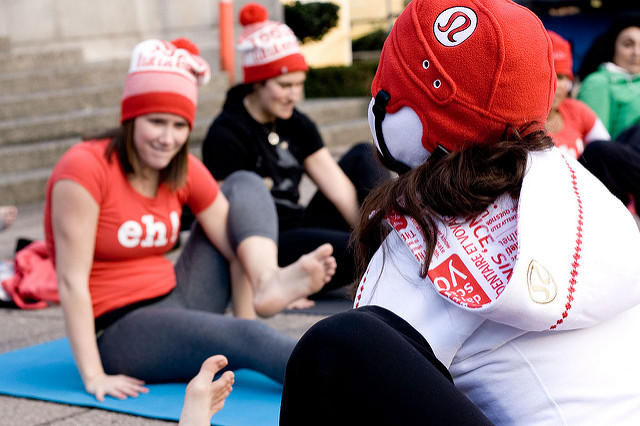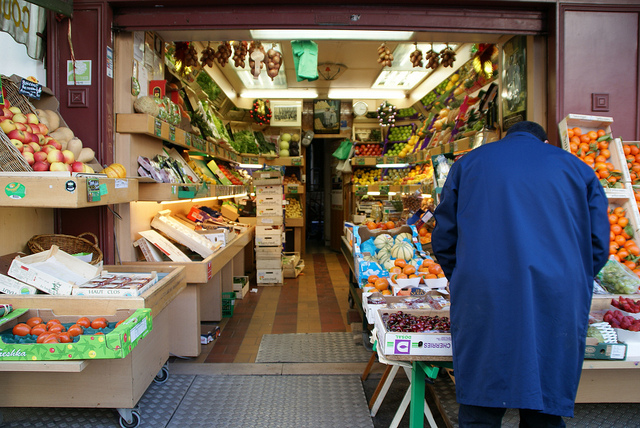Unlock the Magic in Your Story Now
Get the Free 20 questions to Ask Before Launching Your Idea workbook when you sign up for occasional updates.
Get the Free 20 questions to Ask Before Launching Your Idea workbook when you sign up for occasional updates.
Articles filed in: Marketing
The Alternative To Winning The Awareness Game
filed in Marketing, Storytelling, Strategy
 The top 200 advertisers in the U.S. spent $137.9 Billion on ads in 2014. When you’ve got those resources it’s easy to play the awareness game.
The top 200 advertisers in the U.S. spent $137.9 Billion on ads in 2014. When you’ve got those resources it’s easy to play the awareness game.
What if newspaper presses came to a stop and banner ads were abolished on the grounds of inciting mindless consumption? Imagine a world where billboards were torn down to combat visual pollution and TV channels stopped interrupting programs with commercials.
What would our options to woo our customers be then?
There is more than one way to become both top of mind and close to heart. Patagonia employs 45 full time technicians to repair customer’s old and damaged clothing for free. Warby Parker offers a 5 day home try-on service. Tenzing Men’s Skincare sends free samples to prospective customers. Our local cafe invests in staff training to ensure that customers experience the best service in the world. Lululemon holds complimentary yoga classes and events. And these businesses link their sales to giving impacts with the help of B1G1.
What could you commit part of your advertising budget to in order to get closer to your customers?
Image by Shinsuke Ikegame.
The Moments In Between
 On a recent international flight, a colleague was upgraded from Business Class to First Class.
On a recent international flight, a colleague was upgraded from Business Class to First Class.
The four cabin crew had only eight passengers to look after, so they could be extra attentive. The in-flight service was stellar. Everything happened quickly and smoothly, the menu was more varied and the seats more comfortable.
But for all of that by the end of the journey, he concluded that there’s very little to differentiate one experience from the other while you’re in the air. A lot of the value is created before boarding and after landing—during the moments in between. What made flying First Class exceptional was the seamlessness of the experience while on the ground. No queueing at passport control (the immigration officials come to you), beautiful lounges to freshen up in between flights and unhurried transfers.
We devote most of our energy and resources to delivering spec—on the things customers should expect from us, but it’s the moments in between where we have the opportunity to excel, differentiate and delight.
Where are your moments in between? How can you use them to give the customer a story to tell?
Image by simplethrill.
7 Steps To Becoming A More Strategic Marketer
 As marketers we spend much of our time and energy on tactics. We agonise over the creation of lead magnets, spend countless hours honing sales pages and perfecting social media promotions.
As marketers we spend much of our time and energy on tactics. We agonise over the creation of lead magnets, spend countless hours honing sales pages and perfecting social media promotions.
How To Become A More Strategic Marketer
1. Take a long-term view of your business, one that doesn’t require you to go for quick wins.
2. Find a group of people you care about serving.
3. Listen to what they say and watch what they do.
4. Create a product or service you believe in, one that solves problems and satisfies wants and needs.
5. Trust the people you made it for.
6. Stop selling to and start connecting with people, talk about why you made what you made.
7. Rinse and repeat.
There’s nothing more magnetic to your potential customers than the feeling of being seen and understood. That’s the number one job of your marketing.
Image by Don Harder.
The Power Of Customer Context
filed in Marketing, Storytelling, Strategy
 There’s a tiny hole-in-the-wall florist in the heart of the city, close to big office buildings and the cafes where people meet for breakfast and lunch. If it were an ordinary florist it would be the kind of place people would walk past on their way to somewhere else.
There’s a tiny hole-in-the-wall florist in the heart of the city, close to big office buildings and the cafes where people meet for breakfast and lunch. If it were an ordinary florist it would be the kind of place people would walk past on their way to somewhere else.
The neighbouring florist’s made-to-order, elaborate, cellophane-wrapped bouquets don’t cater to commuting office workers who live in small apartments on modest budgets. Meanwhile, the hole-in-the-wall sells out of simple, inexpensive, glass jars filled with wildflowers. The owner understands the power of the context in which the customer experiences his brand and how his product fits into her story.
There’s no need to second-guess the gesture of buying a little bunch that’s perfect for cheering up the corner of a desk on Monday morning (no vase or pre-ordering required), and no excuse not to celebrate the start of the weekend on the way to the tram on Friday night.
The more we put the customer at the centre of our marketing, the more we leave room for their story, the better our results will be. How are you doing that?
Image by mimmyg.
How To Optimise For Customer Delight
filed in Marketing, Storytelling, Strategy
 “You’re here for the Valium?” blurted the dental receptionist as they arrived.
“You’re here for the Valium?” blurted the dental receptionist as they arrived.
The young man looked blankly at her and then at his mother. He was about to have three wisdom teeth removed under local anaesthetic. He had arrived early to be prepared for the procedure and dutifully took the 20mg of Valium given to calm him without understanding why. The dentist would be with them in an hour. Meanwhile, the receptionist continued through her checklist with the best of intentions, getting documentation signed and giving aftercare advice. The boy’s Dad pointed out three mistakes on the consent form before he signed it. All the while Sesame Street blared away on the television in the background of the otherwise empty waiting room.
Regardless of whether the procedure went well the level of empathy, attention to detail and care could have begun long before the patient sat in the dentist’s chair.
Every day we take our customers on a journey, along that journey there will be ‘moments of truth’—opportunities to either disappoint or delight. We often think of ‘moments of truth’ occurring in times of a customer service crisis and focus a lot of our energy on delighting in those moments, but ‘moments of truth’ happen routinely.
There are certain “givens” that customers expect, and they’re disappointed if they don’t happen. Then there are opportunities to create ‘magic’ which is where we often focus our customer service efforts. It’s natural to want to delight but we sometimes forget that focusing on the “givens” is as important as delivering the magic.
In our rush to delight the customer we can overlook the basics.
Paying attention to the ‘givens’ as much as the magic is how we delight. We must do both.
What are the “givens” in your customer’s journey and where is there an opportunity to create magic?
*Download and the Customer Delight PDF to make lists of opportunities you have to meet expectations and to create magic. Use this list to refine the customer experience and optimise for delight.
Image by Miss Messie.
How To Build Brand Equity
filed in Marketing, Storytelling, Strategy
 The toilet paper manufacturer has seemingly found a new way to increase customer engagement and build brand equity. Instead of just embossing patters on the paper, the company has decided to emboss its logo on every sheet. Imagine the meetings, time, energy and a myriad of other resources (including retooling of machines) that went into making and implementing this marketing decision. Now imagine the conversation that started the company on this journey to finding ways to create brand equity. Phrases like ‘captive audience’ (not so much), and ‘increased brand awareness’ were probably used, leading to many of the wrong questions being asked and answered.
The toilet paper manufacturer has seemingly found a new way to increase customer engagement and build brand equity. Instead of just embossing patters on the paper, the company has decided to emboss its logo on every sheet. Imagine the meetings, time, energy and a myriad of other resources (including retooling of machines) that went into making and implementing this marketing decision. Now imagine the conversation that started the company on this journey to finding ways to create brand equity. Phrases like ‘captive audience’ (not so much), and ‘increased brand awareness’ were probably used, leading to many of the wrong questions being asked and answered.
Brand equity is not created by sticking a logo where a customer has no choice but to see it. Brand equity evolves when the brand is so meaningful to the customer that it becomes part of her story. It doesn’t happen when she sees the logo, but when she wants to be seen with it. Big difference.
The reason the backpacker at the airport covers every part of her 15 inch Macbook apart from the Apple logo with a heavy duty protective case, is because she wants people to know that she is part of the Apple tribe. Her Macbook is as much a part of her identity as the battered, bright yellow, sticker-covered violin case she rests her foot on while she surfs the Internet in the departure lounge.
We don’t commandeer brand equity with adverts or increased exposure. We earn it when we change how the customer feels about herself in the presence of our brand. And yes, it’s even possible to do that with a toilet paper brand, just not in the way we might have done fifty years ago.
Image by Shandi-lee Cox..
Good Marketing
filed in Marketing, Storytelling
 As she’s scanning organic bananas or buckwheat kernels at the checkout the assistant at local health food store strikes up a conversation. She’s curious to know if the bananas are just for making smoothies and what the customer uses the buckwheat for. These seemingly insignificant interactions are hardly worth remembering and yet over time they spark ideas for new menu items to be introduced at the in-store cafe and give rise to opportunities to better serve her community of customers.
As she’s scanning organic bananas or buckwheat kernels at the checkout the assistant at local health food store strikes up a conversation. She’s curious to know if the bananas are just for making smoothies and what the customer uses the buckwheat for. These seemingly insignificant interactions are hardly worth remembering and yet over time they spark ideas for new menu items to be introduced at the in-store cafe and give rise to opportunities to better serve her community of customers.
Good marketing starts with the customer’s needs and wants, not with the company’s emergency.
A great marketing strategy is geared towards creating lasting connections instead of simply being focused on reaching short term targets.
The gifted marketer doesn’t simply try to sell what’s in stock today. She strives to understand what her customer will want tomorrow and then creates the culture and momentum to deliver that.
If your success and profits are by-product of satisfied customers, it stands to reason that your priority is to matter, not simply to make and sell.
Image by G. Morel.
 How is it that we can go into the same cafe two days running, order the same drink, pay the same price and yet leave feeling entirely different about the experience depending on the interaction we have with the person who is serving?
How is it that we can go into the same cafe two days running, order the same drink, pay the same price and yet leave feeling entirely different about the experience depending on the interaction we have with the person who is serving? Grace is 32 years old, she has worked hard to establish herself on the career ladder and bought her first home. Grace and her partner Mike are trying for a baby. As marketers with a brand story to tell we’re in a hurry to gather as much data as we can about Grace. We want to know her postcode, where she shops and what she chooses. We want to know how much she earns and how many people live in her household. Of course, there are companies, algorithms and applications that can filter this data for us.
Grace is 32 years old, she has worked hard to establish herself on the career ladder and bought her first home. Grace and her partner Mike are trying for a baby. As marketers with a brand story to tell we’re in a hurry to gather as much data as we can about Grace. We want to know her postcode, where she shops and what she chooses. We want to know how much she earns and how many people live in her household. Of course, there are companies, algorithms and applications that can filter this data for us. Every day you delete messages received from faceless SEO companies who have “noticed you could have a lot more hits to your website”. We are often mistakenly led to believe that our biggest challenge is getting more people to pay attention to our products, services or work.
Every day you delete messages received from faceless SEO companies who have “noticed you could have a lot more hits to your website”. We are often mistakenly led to believe that our biggest challenge is getting more people to pay attention to our products, services or work.